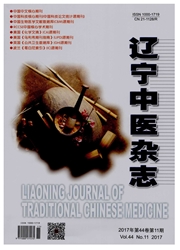

 中文摘要:
中文摘要:
目的:引入系统生物学的观察方法,研究温补药物治疗肾阳虚证兄妹疗效的分子生物学特征,探索基因芯片在中医诊治学中应用的可能性。方法:用40项肾阳虚证量表和40项寒证量表,调查一对兄妹在治疗前后的症状积分;用18816点阵的基因芯片测试在治疗前后的基因表达水平。结果:评定兄妹温补之后肾阳虚与寒证症状的积分下降1/3~2/3,得到在兄妹治疗前的差异表达治疗后入正常值的84条共同基因,其中38条已知基因功能,包括免疫、生长发育等6类。讨论:肾阳虚与寒证治疗效果可以用38条共同调节的基因表达水平和量表积分来分析,两者之间的相关关系值得深入探讨。从系统生物学的观点,用基因差异表达来评价辨证治疗疗效,为中医证的疗效评价提供了一个新的方法.
 英文摘要:
英文摘要:
Objective:Identify the system biology characteristics before and after wanning and recuperating drug treatments for sibling patients with typical Kidney-yang deficiency ; explore the application of cDNA microarray in the assessment of therapeutic efficacy of Traditional Chinese Medicine. Methods : Use 40-items scoring tables for kidney-yang deficiency syndrome and cold syndrome to obtain cumulative scores for pre- and post- warming and recuperating drug treatment of sibhng patients with typical Kid- ney-yang deficiency and use cDNA microarray to study their differentially expressed profiling. Results : The cumulative scores were reduced by 1/3 for the brother patient and 2/3 for the younger sister patient. A total of 84 differentially expressed genes return normal, among which the functions of 38 genes were known, and 16 genes were consistently up- and down-regulated for both brother and sister patients. Conclusion:The therapeutic efficacy of wanning and recuperating drug treatment could be reflected in the regulations of gene expression in conjunction with the cumulative scores for clinical assessments. The main patterns of the svn-drome and gene class are related. The combination of clinical assessment and differentially expressed gene profiling at the molecular level could provide a new approach to evaluate the therapeutic efficacy of Traditional Chinese Medicine.
 同期刊论文项目
同期刊论文项目
 同项目期刊论文
同项目期刊论文
 期刊信息
期刊信息
